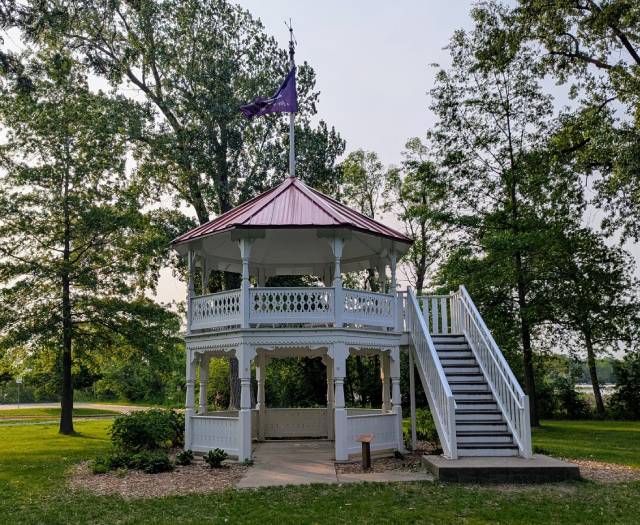In the summer of 1883, Erd completed the gazebo as a wedding gift for his daughter Anna and her husband, Emil Geist, a jeweler from St. Paul. Positioned prominently on their south shore property, the two-story structure served both as a private retreat and a symbol of the family's investment in the refined lifestyle emerging in White Bear Lake's growing resort area. In 1911, the gazebo's lower section was enclosed so it could be used as a honeymoon cottage for family members.
After sitting for many years in disrepair, and likely facing demolition, the property's then-owner donated the gazebo to the White Bear Lake Women's Club in 1973. Negotiations with the city provided a new location for the structure at Matoska Park near the Manitou Bridge. However, the club encountered several setbacks as the gazebo's ownership changed several times in just a few years. These frequent changes in ownership complicated the restoration and relocation process, leading to delays and uncertainties about the gazebo's future.
Once settled, plans were made to transport the structure across the frozen White Bear Lake in February 1974. However, unseasonably thin ice made the crossing too risky, prompting a last-minute decision to truck the hand-carved gazebo—disassembled into two pieces—over local roads to the west side of the lake. The $2,500 cost of the relocation was covered by donations from local banks and other contributors, including $1,000 from the Minnesota Historical Society. With the move complete, restoration work began in anticipation of dedication.
By the late 1990s, deterioration had once again threatened the structure. The city had been forced to dismantle the gazebo two years earlier when rotting wood compromised the stairs, columns, railings, ceilings, and floors. A community fundraising campaign raised $60,000 for restoration, with local resident and former city attorney Ted Glasrud contributing $40,000 of that total. Restoration work began in early June 2000, and the gazebo was rededicated that July 9th.
Two decades later, another major restoration became necessary. By May 2021, the second-story stairs had deteriorated so severely that the city was forced to board them up for safety. This time, the restoration aimed not just to repair but to upgrade materials for greater longevity while preserving the gazebo's original Victorian character. The city allocated $180,000 for the project—$30,000 from its Parks Fund and $150,000 from an anonymous donor working through the Greater White Bear Lake Community Foundation. The completed restoration returned the gazebo to public use on August 14, 2021.
The Erd-Geist Gazebo stands as one of White Bear Lake's most enduring symbols of Gilded Age elegance. What began as a master craftsman's wedding gift to his daughter has evolved into a cherished community landmark, surviving multiple relocations, restorations, and demolition through the persistent efforts of local residents and generous donors. Its Victorian architecture continues to provide a picturesque backdrop for weddings, family photographs, and community gatherings.
 Minnesota Then
Minnesota Then

